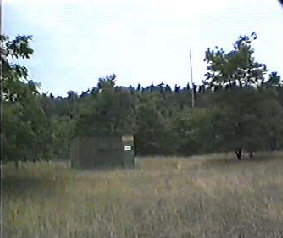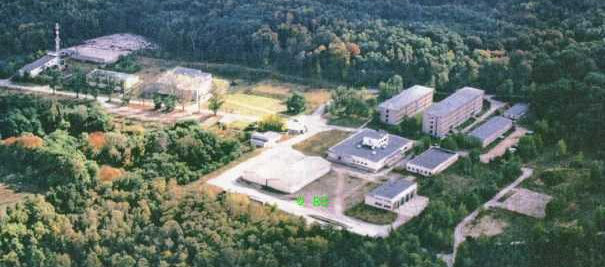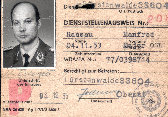Aussenansichten des „Fuchsbaus“ von damals

Davor der Platz der Vergatterung vor Dienstbeginn.

Die Tarnumbauten wurden entfernt.



Das Gebäude 73, in dem sich Lager für Ersatzteile,Meßmittel,Werkstätten und Labor mit eigener 400 Hz-Stromversorgung sowie das Leitzentrum Mikroelektronik der LSK/LV befanden


Das 1984 erbaute Munitionslager der Kaserne außerhalb der Hochspannungssicherungsanlage war für die Aufnahme von bis zu 16 Tonnen Schützenmunition und zwei Tonnen Handgranaten ausgelegt.



Das neue Truppenlager / Kasernenobjekt der NVA-Dienststelle einschließlich Heizhaus, Sporthalle und Klubhaus im Sommer 1990.
Der Haupteingang zum neuen Bunker

Im Vordergrund der Lasteneingang mit einer umhausten Aufzugsanlage. Im Hintergrund das Eingangsgebäude zum neuen Bunker mit Posten- und Garderobenräumen.
Von hier gelangte man durch einen kurzen Tunnel in das unterirdische Treppenhaus.
Genau 93 Stufen führten hinab bis zum 1. Untergeschoß.
Sehr zum Leidwesen der Raucher, die in den Schleusenzeiten den Raucherpavillon neben dem Eingangsgebäude aufsuchen wollten, denn im Bauwerk war das Rauchen verboten.
Der freie Platz wurde anfangs zur täglichen Vergatterung der diensthabenden Besatzung um 7 Uhr benutzt.
Das waren ca. 60 männliche und weibliche Armeeangehörige, die für 24 Stunden dem „Diensthabenden des FBZ" unterstellt wurden.
Nach 1983 fand die Vergatterung meistens vor dem Kopfbau statt.
Der neuerbaute Südteil (TO-01) enthielt den eigentlichen zentralen Führungsraum.
Darin wurden auch auf zwei Projektionsflächen von je 4x4 Metern Größe die ausgewählten Luftbeobachtungsmeldungen automatisch dargestellt.
Vom "ALMAS"- System aufbereitete sekundäre Radarinformationen der militärischen Luftaufklärung konnten von hier bis nach Moskau weitergeleitet werden.

Der im täglichen Dienst hauptsächlich benutzte Eingang zum Bunkersystem im sogenannten „Kopfbau“.
Links der Raum des Postens der Wachkompanie.
Über der Flügeltür vor dem Zugang noch zu erkennen: „Sperrzone P“.
Der weiterführende 40 Meter lange Stollen führt direkt in den schon aus dem 2. Weltkrieg stammenden Bunkerbereich.(TO-02)
Der leicht abschüssige Gang wurde 1995 mit Mauern, Schlackebeton und Stahlplatten verschlossen und ist seit 2006 wieder frei.


Der Lasteneingang zum TO-02

Links der noch versiegelte Lasteneingang des ursprünglichen Fuchsbau-Bunkers, später als TO-02 bezeichnet.
Im Hintergrund die Werkstatt des Gefechtsabschnittes technische Anlagen (GA-VIII).
Daneben befindet sich in einem separaten Bunker das Trinkwasserwerk.


Im Stollensegment G des Altbau-Lasteinganges befanden sich hinter 4 Druck- bzw. Hermetiktüren in 3-fach gestockten Hängebetten hauptsächlich die Ruheplätze des Personals des verantwortlichen Nachrichtenbetriebsbataillons vom NR-14 Waldsieversdorf.
An der Decke noch erkennbar die Betthalterungen und der Frischluftkanal.
Allgemein wurde dieser Bereich als das „U-Boot“ und auch als „Stinkefinger“ bezeichnet, denn beim Betreten des Bauwerkes schlug einem ein Geruch aus Küche, Mensch und Kammerjägermittel entgegen.
Der „Fuchsbau“ im Winter





Die Notausgänge im „Fuchsbau“

Neben dem Zugang durch den Kopfbau war das Betreten auch über den Lasteneingang oder das Eingangsbauwerk möglich.
Links im Bild eine weitere Notausstiegsvariante über die Treppen des Lastenaufzugschachtes

Über Steigleitern gelangte man erst in einen Raum, zu dem auch der Nachrichtenkabelschacht führte und kam dann in der obersten Etage raus.

Durch die ganz unten geöffnete Luke gelangt man in den Gang vor der Flugwetterwarte.
Der Aufstieg durch die senkrechte Rettungsröhre war für die nichtstrukturmäßige Brandschutzgruppe immer eine Möglichkeit zum Luftschnappen auf dem höchsten Punkt des Objektes.
Diese Ausgänge sind für den sportlichen Bunkerbesucher wieder benutzbar.
. . . geheime Ausgänge des „Fuchsbaus“ ? ? ?

Wer schon mal das Gelände rings um die Bunkeranlagen betreten hat, wird mehrere solcher Schächte aus Beton entdeckt haben und hier geheime Ausgänge des „Fuchsbaus“ vermuten, die in alten Bergbaustollen verlaufen könnten.
Tatsächlich verläuft ein mächtiger Stollen östlich der Bunker unter dem Gebäude 073 hindurch.
Diese zum Teil über 100 Jahre alten Gänge sind mit Holzstempel abgesichert gewesen, die inzwischen vermoderten.
So kam es dort 1979 zu mehreren Stolleneinbrüchen mit über 10 Meter tiefen Trichtern.
Im Giebel und in der Fundamentplatte des Gebäude 073 entstand ein langer Riss und das Gebäude mußte für vier Jahre geräumt werden.
In dieser Zeit wurde der Reststollen vom Bergamt Cottbus mit Hochofenasche verfüllt und die Risse im Giebel zur Kontrolle mit Gipsplomben versehen.
Einen Zugang zu dem in 12 Meter Tiefe liegenden Stollen hat es hier allerdings nicht gegeben.
Die Gerüchteküche jedenfalls brodelte und es wurde dann von weitläufigen Tunnelsystemen bis in die umliegenden Ortschaften geredet.
Unterstützt wurde das alles noch durch die unter größter Geheimhaltung von NVA-Bausoldaten ausgeführten Grabungen für die unterirdischen Elektroenergie- und Fernmeldekabel, sowie die bis zum Petersdorfer See verlaufende Kanalisation für das verbrauchte Kühlwasser.
Die Legenden von geheimen unterirdischen Tunneln aus der Kriegszeit, die bis an den Bunker heranführen sollen, bestehen hartnäckig weiter.
Doch bis zum heutigen Tag wurden noch keine gefunden.
Um das Rätsel auf dem obigen Bild zu lösen:
Der mit einer Stahlluke verschlossene Schacht ist leider nur einer von 10 Tiefbrunnen, die das Kühlwasser für das Schutzbauwerk lieferten.
